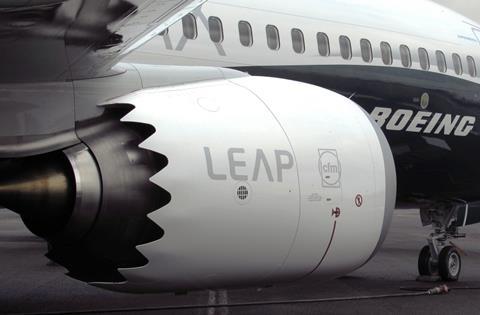Citing the risk of dual-engine power loss, the US Federal Aviation Administration has prohibited airlines from adding a DuPont-made biocide to the fuel of Boeing 737 Max.
An airworthiness directive effective 15 July requires 737 Max operators to remove fuel treated with the biocide from Max tanks and engines prior to first flight.
The order, which applies to DuPont’s “Kathon FP 1.5 biocide”, affects 75 737 Max of US registry, nearly the entire delivered US Max fleet.
CFM International Leap-1Bs power 737 Max.

The biocide concern has no relation to the flight control issue that prompted the Max’s grounding. The type remains grounded, though Boeing has predicted certification will occur in the coming months.
Biocides are added to aircraft fuel to counter the spread of microorganisms that, if water accumulates in fuel tanks, can feed on fuel hydrocarbons.
According to the FAA, biocides can cause salt crystals to form in fuel. Those crystals can cause engine issues, potentially including dual-engine flameouts and power losses, according to the FAA.
A 787 powered by GE Aviation GEnx-1B turbofans suffered such an issue in March after that aircraft’s fuel tanks had been treated with Kathon FP 1.5. Both the 787’s engines lost thrust during descent into Kansai, Japan.
The 737 Max’s Leap-1Bs, having “similar fuel system architecture” as the GEnx, “are also considered susceptible to a multi-engine loss-of-thrust-control event”, the FAA says.
UK investigators also believe an excess of biocide caused a dual-engine issue affecting a CFM56-powered Titan Airways Airbus A321 earlier this year. In that case, an engineer added 37 times more biocide than permitted.
The FAA’s directive says biocide can be flushed from a Max’s fuel systems by adding non-treated fuel to its tanks, and operating the jet for 30 cycles.
In addition to prohibiting airlines from operating Max with Kathon-treated fuel, the FAA is requiring airlines to remove affected fuel from jets through a process described by Boeing in a June memo to all Max operators.
Additionally, the FAA’s order requires operators install placards on Max specifying that the biocide should not be added to fuel.
Boeing did not provide more information to FlightGlobal.
GE Aviation, which co-owns CFM International, says it is “well aware of the issue and have been proactive in communicating to GE and CFM operators about proper use of biocides”.
According to Boeing’s June memo, CFM also addressed the issue in a service bulletin and has scratched Kathon from its approved fuel additives list.
DuPont withdrew Kathon FP 1.5 from the aviation market in March, the FAA notes.
The FAA also issued an information bulletin in March warning that issues could arise if operators add more biocide to fuel than recommended.
Story updated on 17 July to include comment, below, from Boeing.
Boeing says “misapplication of Kathon FP 1.5 biocide and the risk of resulting adverse engine operation is a well-understood concern within our industry. Since 2019, engine manufacturers and Boeing have been working with operators to mitigate disruptions associated with the misapplication of biocides.”
The airframer adds that “the risk of misapplication of aviation fuel biocides is not limited to a single model engine”.
Story corrected on 16 July to include a comment from GE Aviation.


























